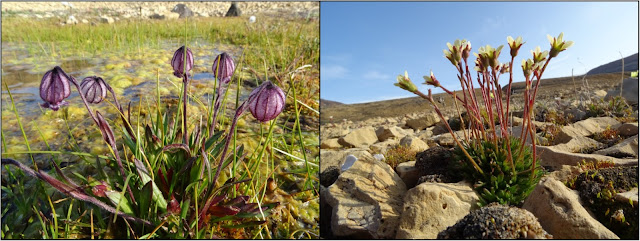This year I decided to do a bit of plant hunting and collect
herbarium specimen of all the plants that grow at Alexandra Fiord. This turned out
to be a rewarding and instructive endeavour. I learnt so much about the plant
species and where they grow at Alex. I improved my ID skills of species I was less
familiar with, particularly the sedges and grasses, and it gave me an
opportunity to explore new areas of Alexandra Fiord. Over the summer I
collected 75 different vascular plant species out of the 115 species that have
been found at Alex over the past 40 years.
Ferns are not that common in the High Arctic. The High Arctic is a polar
desert with little water for transporting the fern spores for reproduction. The
cold winters are also often too severe for ferns to survive except for in the
most sheltered spots. I was quite surprised to find three different species of
fern at Alex from the robust looking Fragrant Shield Fern (Dryopteris fragrans) to the delicate Fragile Fern (Cystopteris fragilis). The fern species
most commonly found at Alex is the Smooth Cliff Fern (Woodsia glabella). All three were only found in sheltered spots
under rock overhangs, in rock crevices and where the snow lies deep in winter.
 |
| The three species of fern that grow in Alexandra Fiord. From left to right Fragrant Shield Fern (Dryopteris fragrans), Fragile Fern (Cystopteris fragilis) and Smooth Cliff Fern (Woodsia glabella) |
It is hard to believe that one could get excited over a dandelion but I
did! The only place where the dandelion (Taraxacum
phymatocarpum) grows around Alex is even named Taraxacum Ridge. I find it
interesting that at my field site at Lake Hazen, which is further north and at
a higher elevation, species of dandelion are more common but ferns are rarer.
Taraxacum Ridge is a small rocky outcrop rising just a few 10s of meters above
the surrounding glacial valley bottom and yet it was a Mecca for unusual
plants. In this rocky outcrop, I also found 2 species of fern and Pallas’
wallflower that rarely grow elsewhere in the valley.
 |
| The rarely seen dandelion (Taraxacum
phymatocarpum) growing at Taraxacum Ridge, Alexandra Fiord |
Another Mecca for plants was in Helms Deep. This is a deep gorge carved
out by a glacial river at the head of the valley. Towards the end of the field
season, when I was now left with only the rare and unusual plants to find, I
hiked up into the gorge and over the Dome behind in search of plants. In Helms
Deep gorge on the south facing slopes, I observed plants growing bigger and
more vigorously than in the valley. I was excited to find just 2 plants of
Arnica (Arnica angustifolia), neither
of which flowered and clumps of the Arctic Harebell, (Campanula uniflora). Unfortunately, I found the Harebell too late
in the season to see its beautiful blue flowers, just the fruits were present
when I found these plants.
The melt water ponds around camp also proved to be fruitful places to
find plant species. I found 2 species of grass that I found nowhere else: Semaphore
Grass (Pleuropogon sabinei) and Vahl's Alkali Grass (Puccinellia vahliana). The aptly named
Semaphore Grass has very distinctive with a pretty flower stem, the flowers are a
bright purple-pink and grow in downward-pointing spikes from the stem like
outstretched arms. Mean while the Vahl's Alkali Grass has a bushy inflorescence
that glows bronze in the sunlight. One of my favourite grasses and one that
only grows at a couple of spots along the banks of the glacial rivers from Twin
and Helms Deep glaciers is the Alpine Sweet Grass (Heirochloe alpina), it forms lovely tall clumps of flowering stems
and has a very distinct spicy sweet smell.
At another melt water pond not far from camp where the
Inuit families that lived at the RCMP post made their summer camp I found a treasure
trove of cool plants that I rarely saw elsewhere at Alex. These included Edwards
Eutrema (Eutrema edwardsii), and Scurvy
Grass (Cochlearia groenlandicum) from
the mustard family (Brassicaceae), Scheuchzer's Cotton-grass (Eriophorum scheuchzeri) with its lovely white pompom flower, Nodding Campion (Silene uralensis) and Tufted Saxifrage (Saxifraga cespitosa).
 |
| Nodding Campion (Silene uralensis) and Tufted Saxifrage (Saxifraga cespitosa) growing at the pond at the Inuit summer camp at Alexandra Fiord. |
It was always exciting to come upon a plant species that I
was looking for, many I found by chance but others I knew roughly where to look
for them. The crowberry (Empetrum nigrum)
is quite common further south in Nunavut, I saw it all over the tundra around
Iqaluit, Baffin Island. However, it is extremely rare at Alexandra Fiord. It had
been found before on a steep heather slope leading up to the East Ridge of the
valley but try as we might, with an almost grid like search, we never did find
it on this slope this year or last year. By chance we did, however, find
several patches of the Crowberry on Skraeling Island.
 |
| The crowberry (Empetrum nigrum)
with autumn colouring in early August. We found a rare patch of this heather related species on Skraeling Island. |




No comments:
Post a Comment